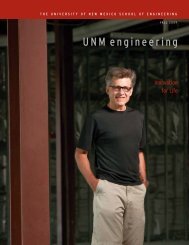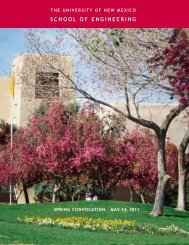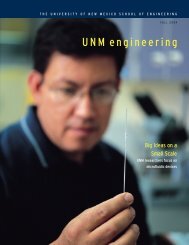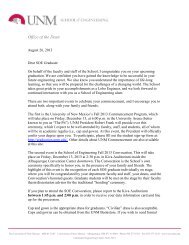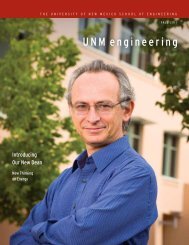UNM engineering - School of Engineering - University of New Mexico
UNM engineering - School of Engineering - University of New Mexico
UNM engineering - School of Engineering - University of New Mexico
Create successful ePaper yourself
Turn your PDF publications into a flip-book with our unique Google optimized e-Paper software.
Dimiter Petsev, assistant pr<strong>of</strong>essor <strong>of</strong> chemicaland nuclear <strong>engineering</strong>, and Jeremy Edwards,assistant pr<strong>of</strong>essor <strong>of</strong> molecular genetics andmicrobiology and assistant pr<strong>of</strong>essor <strong>of</strong> chemicaland nuclear <strong>engineering</strong>, have been collaboratingthrough the CBME for a year and a half.In just two years, the center has received $8 million in grants.“We’ve already produced a 17-to-1 return on the university’sinvestment,” says Gabriel Lopez, director <strong>of</strong> the CBME andpr<strong>of</strong>essor <strong>of</strong> chemical and nuclear <strong>engineering</strong> and chemistry.“We’re really proving that this kind <strong>of</strong> collaboration can beachieved here at <strong>UNM</strong>.”“test tubes” using a customized microscope, one <strong>of</strong> onlytwo in the world. The collaboration, which also involvesresearchers at Harvard <strong>University</strong>, is organized by the CBMEand is part <strong>of</strong> the National Science Foundation Partnershipfor Research and Education in Materials: <strong>UNM</strong>/HarvardPartnership for Leadership in Biomaterials.Here’s how some CBME researchers are <strong>engineering</strong>better medicine:Droplets <strong>of</strong> DNAImagine a billion glass test tubes lined up, row after row, ina gigantic laboratory. Now, shrink that picture. Way down.Dimiter Petsev, assistant pr<strong>of</strong>essor <strong>of</strong> chemical and nuclear<strong>engineering</strong> is using his expertise in micr<strong>of</strong>luidic devices t<strong>of</strong>abricate miniaturized test tubes made <strong>of</strong> water droplets.Jeremy Edwards, assistant pr<strong>of</strong>essor <strong>of</strong> molecular geneticsand microbiology and assistant pr<strong>of</strong>essor <strong>of</strong> chemical andnuclear <strong>engineering</strong>, plans to use billions <strong>of</strong> these tiny testtubes to develop a fast, inexpensive way to sequence theDNA <strong>of</strong> patients with different cancers or even an individual’sentire genome.Each tiny drop, about ten microns in diameter, is loaded witha small fragment <strong>of</strong> DNA and a bit <strong>of</strong> reactant. Then, thedroplets are suspended in an oil emulsion and used for tests.Once the droplets are floating in the emulsion, Edwards usesa chemical process to break the droplets open. He reads thebiochemical results emanating from streams <strong>of</strong> these brokenPetsev’s challenge is to fabricate these minute droplets in auniform size and shape. With input from Harvard researchers,Petsev has achieved very fast production <strong>of</strong> highly uniformdroplets using micr<strong>of</strong>luidic devices formed using a processcalled s<strong>of</strong>t lithography. Through this process, a network <strong>of</strong>channels 10-100 micrometers deep and wide can easily beformed in a silicone rubber material. Petsev then bonds theprinted polymer channels on a glass slide and uses pressureor electric fields to force oil and water through separatechannels. The droplets form where the channels intersect.Petsev’s next challenge is perfecting the process <strong>of</strong> loadingthe DNA fragments into the droplets.Petsev and Edwards have been collaborating through theCBME for a year and a half. Petsev says access to the CBMEfacilities has been critical, but the opportunity to collaborateis most important. “There’s an exchange <strong>of</strong> information andideas here which is very beneficial for our multidisciplinarywork.” Edwards agrees. “I have an <strong>engineering</strong> backgroundbut I don’t have the ability to make micr<strong>of</strong>luidic devices. Withengineers like Dimiter bringing their skills to the table, wecan achieve our goals.”<strong>UNM</strong> <strong>Engineering</strong> 07



